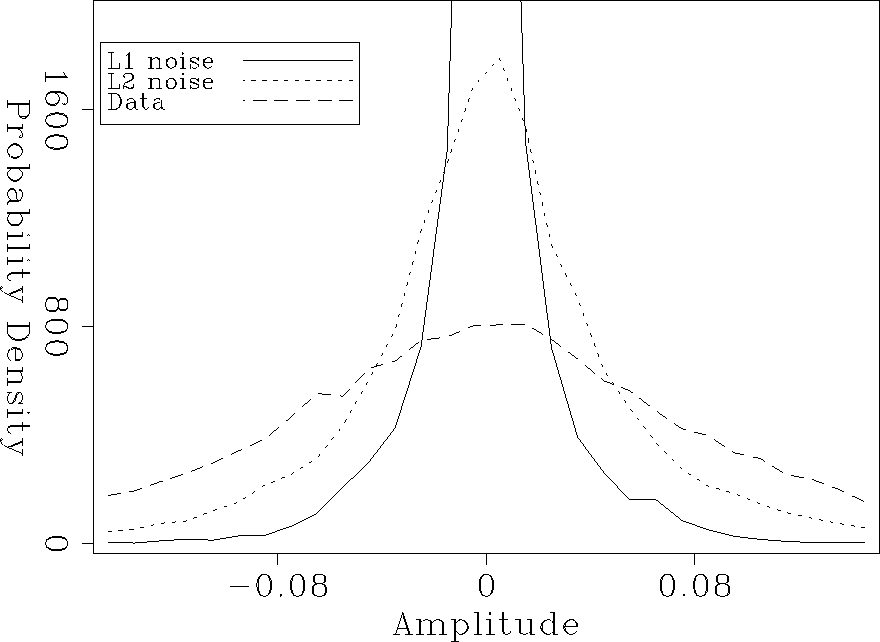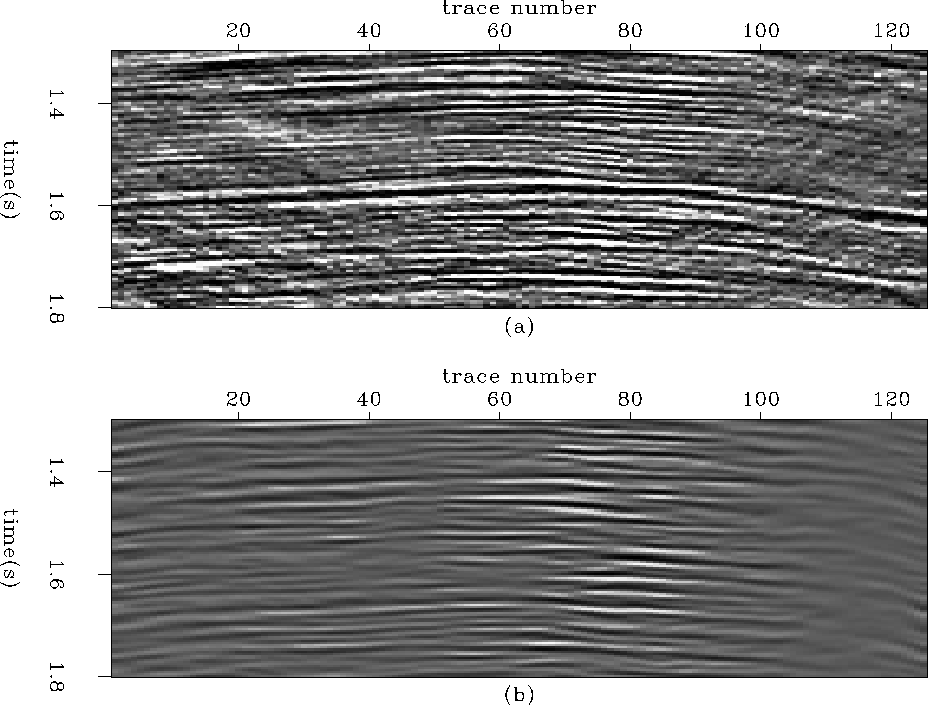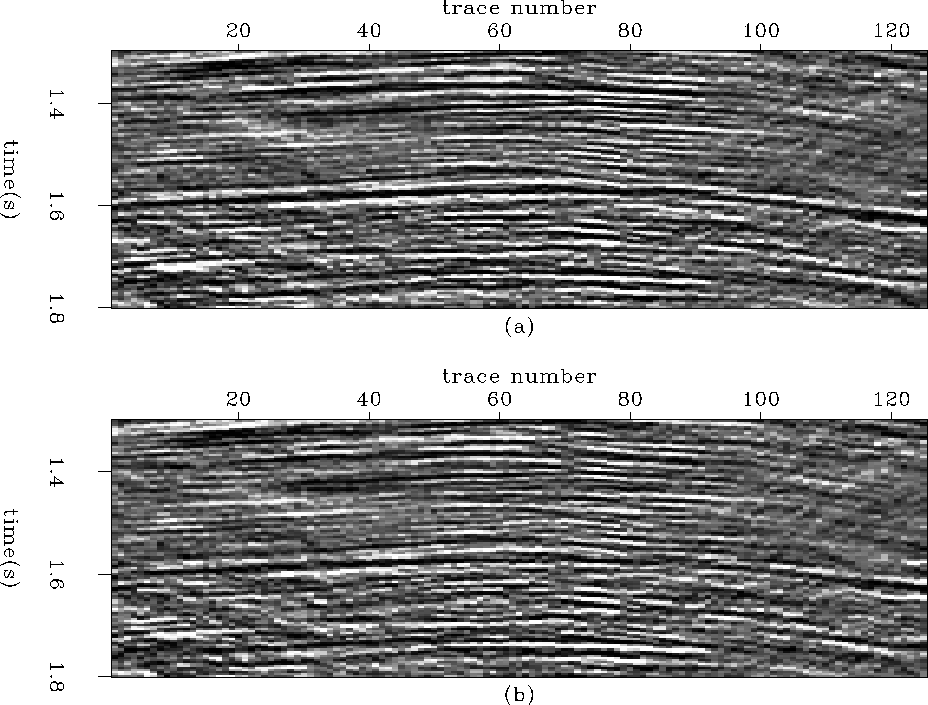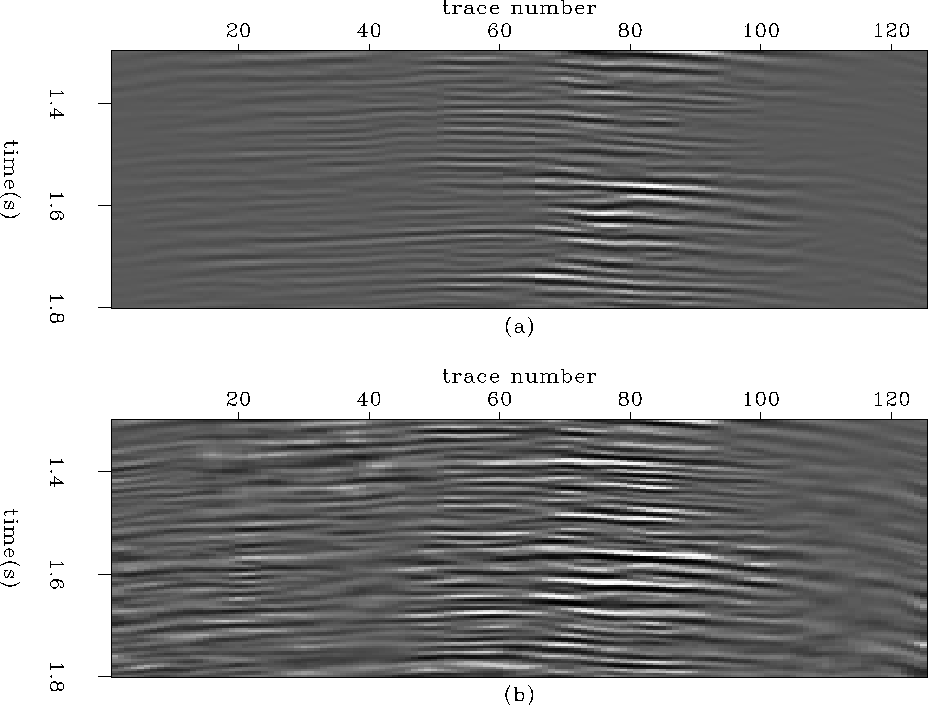




Next: Prestack land data multiple
Up: Guitton and Verschuur: adaptive
Previous: Adaptive subtraction results
In this section we attenuate in the poststack domain
surface-related multiples with shaping filters
that we estimate with the  - and
- and  -norm. These filters are
non-stationary. Figure 10a shows the multiple-infested data.
Figure 10b displays the multiple model computed with
the Delft modeling approach Kelamis et al. (1999). Note that for this
gather, the amplitude differences between the primaries and the multiples
are not very strong.
Our goal is to illustrate the use of the
-norm. These filters are
non-stationary. Figure 10a shows the multiple-infested data.
Figure 10b displays the multiple model computed with
the Delft modeling approach Kelamis et al. (1999). Note that for this
gather, the amplitude differences between the primaries and the multiples
are not very strong.
Our goal is to illustrate the use of the  -norm
in a more general case when surface-related multiples are present in the data.
We specifically focus on the event at 1.6s in Figure 10.
This event is a primary that we want to preserve during the subtraction.
-norm
in a more general case when surface-related multiples are present in the data.
We specifically focus on the event at 1.6s in Figure 10.
This event is a primary that we want to preserve during the subtraction.
Figures 12 displays the estimated signal when
the non-stationary shaping filters are computed with the  and
and
 -norm. The amplitude of the primary at 1.6s is well preserved
with the
-norm. The amplitude of the primary at 1.6s is well preserved
with the  -norm in Figure 11a. However, the amplitude
of this primary is attenuated with the
-norm in Figure 11a. However, the amplitude
of this primary is attenuated with the  -norm as displayed
in Figure 11b. Figure 10 shows a comparison
between the subtracted noise with the
-norm as displayed
in Figure 11b. Figure 10 shows a comparison
between the subtracted noise with the  (Figure 10a)
and the
(Figure 10a)
and the  -norm (Figure 10b). We conclude that
the
-norm (Figure 10b). We conclude that
the  -norm tends to subtract too much energy.
-norm tends to subtract too much energy.
This last example proves that the estimation of shaping
filters can always be done with the  -norm. The good thing
about our inversion scheme and the objective function in equation
(3) is that only one parameter (
-norm. The good thing
about our inversion scheme and the objective function in equation
(3) is that only one parameter ( ) controls the
) controls the
 behavior. Thus we can decide to switch from one
norm to another very easily. In Figure 13, I show
a histogram of the input data and of the estimated noise with the
behavior. Thus we can decide to switch from one
norm to another very easily. In Figure 13, I show
a histogram of the input data and of the estimated noise with the
 and
and  -norms. The theory predicts that the distribution
of the
-norms. The theory predicts that the distribution
of the  result should be gaussian and that distribution
of the
result should be gaussian and that distribution
of the  result should be exponential. Figure
13 corroborates this.
result should be exponential. Figure
13 corroborates this.
win3
Figure 10 (a) Stack infested
with multiples. (b) The multiple model computed with the Delft modeling
approach. The subtraction is done poststack.




 win
win
Figure 11 (a) The estimated primaries
with  -norm adaptive subtraction. (b) The estimated primaries
with
-norm adaptive subtraction. (b) The estimated primaries
with  -norm subtraction. The primary at 1.6s is very attenuated with
the
-norm subtraction. The primary at 1.6s is very attenuated with
the  -norm. The
-norm. The  technique preserves its amplitude
better.
technique preserves its amplitude
better.
![[*]](http://sepwww.stanford.edu/latex2html/movie.gif)




 win2
win2
Figure 12 (a) The estimated
multiples with the  -norm subtraction. (b) The estimated multiples
with the
-norm subtraction. (b) The estimated multiples
with the  -norm subtraction. The
-norm subtraction. The  -norm tends to over-fit some
multiples that creates some leaking of primaries in the estimated noise.
-norm tends to over-fit some
multiples that creates some leaking of primaries in the estimated noise.
![[*]](http://sepwww.stanford.edu/latex2html/movie.gif)





hist7636
Figure 13 Histograms of the input data
and of the estimated noise with the  - and - and  -norms. As
predicted by the theory, the density function with the -norms. As
predicted by the theory, the density function with the  -norm
is much narrower than with the -norm
is much narrower than with the  -norm. -norm.
|
|  |










Next: Prestack land data multiple
Up: Guitton and Verschuur: adaptive
Previous: Adaptive subtraction results
Stanford Exploration Project
6/7/2002
![]() and
and
![]() -norm. The amplitude of the primary at 1.6s is well preserved
with the
-norm. The amplitude of the primary at 1.6s is well preserved
with the ![]() -norm in Figure 11a. However, the amplitude
of this primary is attenuated with the
-norm in Figure 11a. However, the amplitude
of this primary is attenuated with the ![]() -norm as displayed
in Figure 11b. Figure 10 shows a comparison
between the subtracted noise with the
-norm as displayed
in Figure 11b. Figure 10 shows a comparison
between the subtracted noise with the ![]() (Figure 10a)
and the
(Figure 10a)
and the ![]() -norm (Figure 10b). We conclude that
the
-norm (Figure 10b). We conclude that
the ![]() -norm tends to subtract too much energy.
-norm tends to subtract too much energy.
![]() -norm. The good thing
about our inversion scheme and the objective function in equation
(3) is that only one parameter (
-norm. The good thing
about our inversion scheme and the objective function in equation
(3) is that only one parameter (![]() ) controls the
) controls the
![]() behavior. Thus we can decide to switch from one
norm to another very easily. In Figure 13, I show
a histogram of the input data and of the estimated noise with the
behavior. Thus we can decide to switch from one
norm to another very easily. In Figure 13, I show
a histogram of the input data and of the estimated noise with the
![]() and
and ![]() -norms. The theory predicts that the distribution
of the
-norms. The theory predicts that the distribution
of the ![]() result should be gaussian and that distribution
of the
result should be gaussian and that distribution
of the ![]() result should be exponential. Figure
13 corroborates this.
result should be exponential. Figure
13 corroborates this.


![[*]](http://sepwww.stanford.edu/latex2html/movie.gif)

![[*]](http://sepwww.stanford.edu/latex2html/movie.gif)
